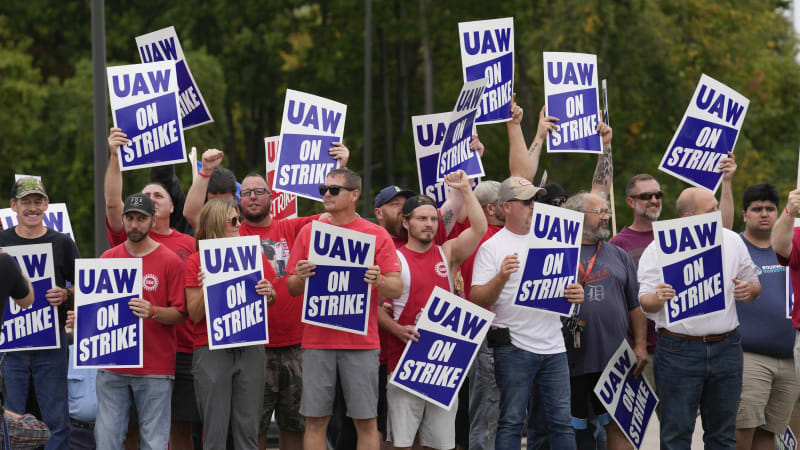UAW Big Three auto strikes are 'Survivor' on an industrial scale

DETROIT — The United Auto Workers, now in the 19th day of strikes, are employing a bold strategy that places the Detroit Three automakers into a high-stakes game of “Survivor,” featuring a weekly decision on which factories the strike will hit next, with layoffs mounting, suppliers hurting and harsh rhetoric from both sides.
UAW President Shawn Fain has transformed the rituals of contract talks with General Motors, Ford and Chrysler parent Stellantis into a high-stakes, made-for-media game. The automakers will look for clues on how to survive in the agreement the union reached on Sunday with Volvo Group-owned Mack Trucks.
For now, the union appears to be in control, although there is pain on both sides. GM and Ford said Monday they were indefinitely laying off another 500 workers at four Midwestern plants, citing the impact of the walkouts.
Analysts looking ahead to third-quarter financial results this month are starting to reckon the costs of what the UAW calls “stand-up strikes.” JP Morgan estimated GM has lost an unrealized $191 million in operating profit, and Ford $145 million already.
Those are large sums, but not in the context of GM or Ford, which have forecast combined pre-tax profits of up to $26 billion for this year.
The daily cost of the strikes is almost certain to rise weekly, JP Morgan added. The real pain will start if the UAW orders walkouts at factories that build Ford, Chevrolet and Ram pickup trucks and large SUVs such GM’s Cadillac Escalade.
At the current pace, it could take the UAW weeks to get to those factories.
“We have the power to keep escalating and keep taking plants out,” Fain said in a video address on Sept. 13. “This is going to create confusion for the companies. This is going to keep them guessing on what will happen next.”
Limited strikes
Last Friday, the UAW displayed the effectiveness of its strategy of launching limited strikes at all three companies at once, rather than tackling each company one at a time as in the past.
Fain was prepared to order walkouts at one assembly plant for each of the three automakers. At the last minute, he decided not to order a strike at a Stellantis factory because the parent of Chrysler offered new concessions minutes before the union president’s scheduled a Facebook Live address.
The previous week, Ford got a pass when it made more favorable job security and inflation protection proposals. UAW workers at GM and Stellantis parts depots walked off the job, while Ford’s employees kept shipping parts to dealers.
The rules of the game are clear: For automakers to avoid a wider walkout and more lost revenue, they must make new steps toward satisfying union demands by Friday’s deadline.
“It is negotiations that are evaluated by the UAW weekly,” said Harley Shaiken, labor professor at the University of California Berkley. “Now, if you don’t give something that the union wants, you will have another plant on strike.”
The CEOs of GM and Ford last week accused Fain of misrepresenting the state of bargaining and spending too much time on television and not enough at the bargaining table. Both stopped short of accusing the UAW of bad faith bargaining, but they both accused Fain of putting the companies and union jobs at risk.
“The UAW is pitting the companies against one another,” GM CEO Mary Barra said in a statement Friday. “But it’s a strategy that ultimately only helps the non-union competition.”
Battery plants
Ford CEO Jim Farley warned that suppliers to the automaker’s Michigan Assembly plant, which builds Bronco SUVs and Ranger pickups, are on a “knife’s edge” with thousands of jobs at risk.
“What’s really frustrating is that I believe we could reach a compromise on pay and benefits, but so far the UAW is holding the deal hostage over the battery plants,” Farley said.
Ford plans four EV battery plants in the U.S. — three under joint ventures with South Korean battery maker SK On. The fourth would be a wholly-owned facility planned in Marshall, Michigan, to build low-cost lithium-iron batteries with technology from China’s CATL.
Technically, the joint venture plants are separate companies not subject to the labor talks. GM’s joint venture battery plants also have separate status and GM has declined to include them in negotiations.
Nonetheless, Fain has made an issue of lower wages at the battery joint ventures. The union seeks to avoid a situation where non-union, lower-paid battery plant jobs eventually replace UAW-represented combustion powertrain jobs.
What happens next and when is unclear — by design.
The UAW was holding new bargaining sessions with GM and Stellantis on Monday. Company bargainers were likely to seek details of the tentative deal the union struck with Mack Trucks, which if ratified will significantly increase wages for almost 4,000 UAW members at the truck maker.
The sides agreed just before the Sunday night deadline, not long after Fain on Friday had blasted the truck maker of “following the same tired playbook as many of our other employers.”







